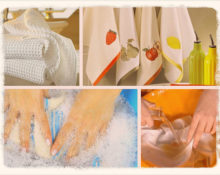The kitchen is the heart of the apartment.
The whole family gathers here, so a good housewife thinks about aesthetic little things in the interior that will add coziness. This item includes kitchen towels. Why do they get dirty most often? Should I try to remove difficult stains at home or throw the product away? How expensive will laundry cost the family budget? Read the answers, as well as traditional methods of getting rid of pollution, in this article.

Why do kitchen towels get dirty very quickly?

Life is in full swing in the kitchen, something is constantly being prepared, washed, preparations are being made for holidays and family events. During the frying and cooking process, housewives often use towels instead of oven mitts; some replace table rags with them. Usually, grease and dirt are firmly embedded in the fabric and become difficult to wash off. Stains from food, dyes and grease can be removed using modern or traditional methods.
How to wash a lightly soiled towel?

This option is only suitable for products that have been used for 3 days or less. It is enough just to wash them in an automatic machine at a certain temperature in combination with the right powder. You don't need to pre-soak it.
White cotton fabrics are washed at a temperature of 90–100˚С. For colored people, 40–60˚С is optimal, not higher.
Eliminating old stains

What if the towel is very dirty and the above method did not help? Everything is very simple – It should be soaked before washing. Firstly, this can be done in the right bleach. Leave it there for an hour. Secondly, leave for 4-5 hours in a mixture of washing powder with 5 tablespoons of soda.
Colored things become discolored by baking soda.
Third, leave in cool salted water (pour a spoonful of salt into a liter of water). After either method, just scroll through things as normal.
Didn't all of the above help? Try traditional methods.
Folk remedies against grease and other stains
Vegetable oil

Surprisingly, it is the oil that fights stubborn stains. To do this, pour about 5 liters of water into a bowl and bring to a boil. Turning off the heat, add powder, bleach and oil (3 tablespoons of all ingredients). Place a towel there, stir a little and cover until completely cool. Afterwards, simply wash the fabric.
Vegetable oil should be added last. If this is not done, a film will form on the surface of the water, which will interfere with the connection of the remaining components, and the stains will remain.
Vinegar

Regular table vinegar helps get rid of grease and mold. You can simply soak the cloth in warm vinegar water. To get it, you need to mix a liter of water and a glass of vinegar 5–9%. Rinse well and hang.Or add half a glass of essence instead of conditioner when washing in a machine.
Set temperature and time to maximum. When rinsing, once in the drum, the vinegar will remove odors. Next, we take out the towels and hang them up.
When working with vinegar, always use gloves to protect your hands.
Soda

Capable of removing old dirty stains. It is used for different types of washing. You need to pour baking soda into the drum of the washing machine or into a basin, wash and rinse the towels. Don't forget to iron it.
Dishwashing liquid

To get rid of greasy marks, you need to take a dry towel and apply detergent for at least 24 hours. After the time has passed, rinse and wash.
When using dishwashing liquid, a lot of foam is formed and streaks remain.
Laundry soap

Perhaps the most affordable of all means that will get rid of old marks. You just need to soap the dirty places, put the cloth in a plastic bag and tie it. Leave for 12 hours and wash the next morning. There will be no trace left of stains.
Glue

How to apply it? Pour 4 liters of water into a bowl and bring to a boil. Pour in a tablespoon of silicate glue with powder, bring to a homogeneous consistency. Place towels there and leave for 30 minutes. All that remains is to wash it in the machine and rinse thoroughly so that the glue does not remain in the fibers.
Colored fabrics will fade from this method.
Lemon acid

Perfectly removes beet and tomato traces. Wet towels should be soaped, rinsed and wrung out. Then drip citric acid onto the stains. After 7 minutes, rinse off under running water.
You can use a little another method:
- dissolve citric acid in 100 g of water and moisten the stain with it;
- leave for 2-3 hours;
- soak the towel in the powder for half an hour;
- wash.
Microwave

You can even wash stains in it. There is nothing complicated here. You should soap the fabric with laundry soap and put it in a plastic bag. Without tying it, roll it up and put it in the microwave for 1.5 minutes at a power of at least 600 W. After a minute break, turn on the microwave for another 1.5 minutes. Then rinse. Dirt and unpleasant odor will disappear.
Boiling

This method will help if there is no washing machine in the house or the towel is very dirty. By boiling you can achieve crystal whiteness, but what to boil with?
General principle of boiling: take an enamel bowl, fill it with 2/3 of water, bring to 100˚C. Add ingredients to prepare the solution.
Add towels and cook, stirring occasionally, over low heat for 30 minutes (longer for heavier stains). Take out the towels, rinse and wash.
For water additives you can use:
- finely grated bar of laundry soap + 3 tablespoons of soda;
- 1 glass of soda;
- a tablespoon of glue and soap per 10 liters of water;
- 50 grams of soda, a small bottle of peroxide and 2 tablespoons of powder per 8 liters.
Synthetics will not survive boiling, so only natural fabrics can be boiled.
4 products for express towel whitening
After removing stains, many products lose their whiteness. You can return it to its original appearance on your own without spending your budget on dry cleaning. Below are 4 of the most effective remedies.
Hydrogen peroxide

The solution will quickly restore freshness to the material. Peroxide actively fights stains of any origin. You can pour them in and leave for 30 minutes, wash and rinse well. Or mix 2 teaspoons of peroxide with a liter of water.Place a towel there for 3 hours and wash after the time has elapsed.
Potassium permangantsovka

This method works flawlessly. In addition to removing stains, it also disinfects. Dissolve 200 grams of powder and a couple of manganese crystals in hot water so that the water acquires a pinkish tint. Soak pre-washed towels in the resulting solution, cover with film and leave for 6–8 hours. Afterwards, rinse well.
Mustard

First, the towels must be washed. Then dilute dry mustard with warm water until smooth and apply the mixture to the stains. Leave for 8 hours or overnight. Don't forget to rinse.
Carry out all manipulations with gloves, as mustard is very hot.
Boric acid

You can buy it at a pharmacy for a small price. Bleaching with this method is possible for thick or waffle fabrics. Add 3 liters of water and 2 tablespoons of acid to the basin. Leave dirty items for 2 hours, then wash and rinse them.
Note to the housewife - how to extend the life of a kitchen towel

- There should always be several towels in stock.
- It is better to use waffle products; terry products have long pile and it is more difficult to remove stains.
- Change the towel every 2-3 days, then it will not have time to get too dirty.
- Choose dark or variegated colors that won't show stains.
- Store dirty ones in a mesh bag. They will dry in them before washing.
- Use only for its intended purpose.
- Wash separately from other items.
- To make the fabric less dirty and wash well, you can add starch when soaking.
- Alternate methods of getting rid of contaminants.
- After washing, dry in the fresh air, because sunlight is a natural bleach.
- To make the fabric smell nice after washing, you can add baking soda and essential oil to the water when rinsing.
- Be sure to iron, it will stay clean longer.


 0
0





